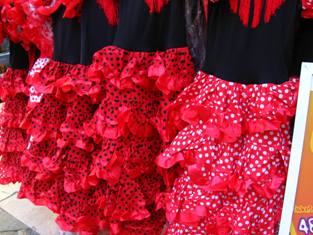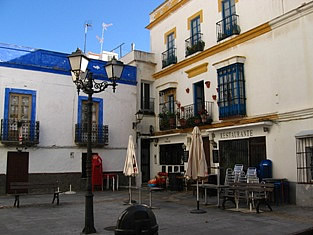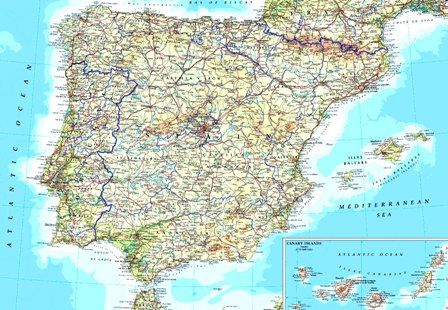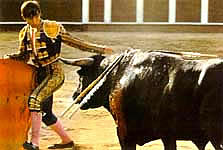Spanish fiestas
Spain is Famous for its Fiesta's. There is no doubt that the Spanish are the most noted Nation for their parties and Celebrations of their rich cultural history and traditions.
Here we have put together a list of the best ones in each region. They really are not to be missed and are great fun for all the family. There are both National Fiesta's, celebrated all over Spain. Alongside these, there are also hundreds of smaller, local Fiesta's in every town and village.
Here is a quick guide to the great Fiesta's of Spain:

Fiestas in every village
January: Three Kings day - D�a de los Reyes Magos (5th January) - This is a Huge celebration which takes place on the evening of 4th January when the Three Kings give out Christmas presents. In most Towns and Large villages there is a street procession where many sweets are given out to the children lining the streets.
February: The Seville Tapas Fair gives you a chance to savour a feast of Spanish snacks in the world capital of tapas.
March: The Festival de Jerez is a flamenco festival with some of Spain's top performers dancing the National dance for your enjoyment.
In Valencia there is the not to be missed Fallas de San Jos� where there are huge street parties with incredible fireworks for a number of nights in a row accumulating in the burning of the fallas (papier-mache effigies of famous people) on the last day.
Springtime fiestas
April: Some of Spain's biggest festivals take place during April and May starting with Holy Week (Semana Santa) which is important nationwide but is especially recommended in Seville, Cordoba, Granada, Malaga and Alicante. The celebration of Holy Week is the highlight of the year, with teams of parish members carrying enormous religious floats. In Torrevieja there is a 'international' float carried by non Spanish Nationals, the majority of whom are English. It is a massive Honour to be asked to take part in the Semana Santa procession and to add to the Glory, the International float is the largest and heaviest float carried without wheels (carried by 100 people).
 In Alcoy, Alicante it's the festival of the Moros y Cristianos where you can see mock battles between Moors and Christians. In Seville, two weeks after Easter you can visit Spain's biggest annual party at the Seville April Fair (La Feria de Abril).
In Alcoy, Alicante it's the festival of the Moros y Cristianos where you can see mock battles between Moors and Christians. In Seville, two weeks after Easter you can visit Spain's biggest annual party at the Seville April Fair (La Feria de Abril).
It is also the Romer�a de And�jar in Andalucia, which is a mass pilgrimage to a shrine of the Virgin Mary.
May: In Granada and Cordoba there is the festival of the Cruces de Mayo where you can see large crosses adorn parishes and the locals party in the streets. Cordoba continues its parties with the Fiesta de los Patios, a competition to find the city's most beautiful flower covered patio. Also in Cordoba, and shortly after the Fiesta de los Patios, you can watch the Feria de Cordoba, a fiesta of flamenco and all things Spanish that now rivals Seville's April Fair in size.
The famous Feria del Caballo, Jerez's Horse Fair is also this month. In Madrid they host the world's largest bullfight festival plus plenty cultural events and parties throughout the month of May, as Madrile�os celebrate San Isidro, the Patron Saint of the capital.
June: On the evening of June 23rd, to celebrate the summer solstice, people flock to the beaches, light bonfires, and party until dawn. The Hogueras de San Juan (midsummer bonfires and fireworks) are celebrated in the south of Spain, especially Alicante.
A little known festival is La Romer�a del Rocio which is a pilgrimage of up to a million people who travel on foot or by horse and carriage to the shrine of the Virgin at El Rocio in Huelva. This is a Fiesta celebrated all over the country but most notably in Toledo and Seville. In Granada you will find the International Festival of Music and Dance.
The Hogueras de San Juan (midsummer bonfires and fireworks) are celebrated in the south of Spain, especially Alicante. At the end of May the annual Sonar Festival which takes in music and art, takes place in Barcelona which attracts huge crowds.
Sumertime fiestas
July: The Festival de Cordoba is an International guitar festival which takes place in the gardens of the Alcazar. In Pamplona the famous San Fermin (running of the bulls) takes place which always begins on 7th July and lasts for a week. In San Sebastian you can see some of the top jazz performers at its annual San Sebastian Jazz Festival.
If you are around the South Coast area on 16th July you will come across a range of different celebrations on the D�a de la Virgen de Carmen. Most commonly you'll see a statue of the Virgin carried in from the sea by a flotilla of fishing boats often with some impressive firework displays.
 August: One of Spain's most fun and totally mad festival is La Tomatina, the Tomato Festival in Bunyol near Valencia which is the world's biggest tomato fight. In Malaga you will find the Feria de Malaga which is a massive 10 day party down on the south coast. Cambados in Galicia hosts the Albari�o wine fair where you can sample some of Galicia's finest white wines.
August: One of Spain's most fun and totally mad festival is La Tomatina, the Tomato Festival in Bunyol near Valencia which is the world's biggest tomato fight. In Malaga you will find the Feria de Malaga which is a massive 10 day party down on the south coast. Cambados in Galicia hosts the Albari�o wine fair where you can sample some of Galicia's finest white wines.
The Elx (Elche) Mystery Play is held in August and dates back to the 13th century. It is one of Spain's oldest cultural events. Even though the play is voiced in Spanish, it is great fun for all non Spanish speaking as the drama and theatre of the event plays out in front of you, you can get the gist of what is happening without having to hear the dialogue.
September: Jerez de la Frontera celebrates its wine harvest with the Jerez sherry festival which begins on the first Saturday of September every year. Known locally as the Fiestas de Oto�o, this is a three week party involving sherry, horses and flamenco.
Catalunya celebrates Cava week, a festival dedicated to the fine Catalan version of champagne. The City of Barcelona celebrates the Festes de la Merce, a huge fiesta with processions, fireworks and dance performances.
In Sueca, Valencia there is a Fiesta del Arroz which is basically a paella festival - A number of local Paella Festivals also take place during September and October in the smaller towns along the coast from Valencia, through Alicante to San Pedro del Pinatar.
.Fiestas in autumn
October: The biggest event this month is in Zaragoza with the Pilar Festival which celebrates the appearance of the Virgin Mary to St James. The event coincides with Hispanidad, a nationwide fiesta commemorating Columbus landing in the Americas.
November: This month begins with the sombre occasion of All Saints Day (Todos Los Santos) celebrated all over Spain. This day is a public holiday where all shops will be closed. Spanish people from all over the country return to their birthplaces to remember their deceased relatives.
 December: The month we all know that celebrates Christmas. Christmas in Spain is a big, traditional family affair with Noche Buena (Christmas Eve) being a very quiet night when all families get together for dinner.Christmas day is not a day when presents are given, this is saved until Three Kings Day (5th January).
December: The month we all know that celebrates Christmas. Christmas in Spain is a big, traditional family affair with Noche Buena (Christmas Eve) being a very quiet night when all families get together for dinner.Christmas day is not a day when presents are given, this is saved until Three Kings Day (5th January).
In Palma de Mallorca cathedral, preparations take the form of morning choruses and the Cant de Sa Sibilla (Hymn to St Sibly). This tradition, spread throughout the south of France, Catalonia, the Balearic Islands and Corsica, was abolished by the Trento Council. Nevertheless, the Bishop of Mallorca decided to allow it to take place, hence its preservation.
In Murcia, the campanas de auroras (dawn bells) group perform their ancient and sober compositions. After midnight on Noche Vieja (New Years Eve) is as raucous in Spanish cities as elsewhere in Europe. You can see Fireworks filling the sky at midnight from miles around as the Spanish see the New year in in style.
